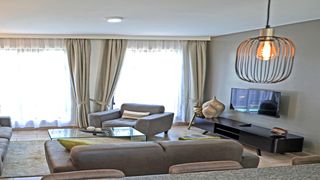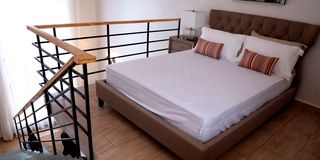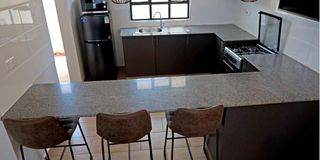
Living room design by Miran residence situated in Ruaka, Kiambu County on February 26, 2024. PHOTO | LUCY WANJIRU | NMG
|Business
Premium
Why youthful city professionals are flocking to Ruaka
What you need to know:
- Ruaka’s proximity to amenities like malls, hospitals, schools, restaurants, fresh produce markets, and hotels is another contributing factor.
- Touted as one of the fastest-growing satellite towns of the Nairobi Metropolis, Ruaka is just a 22-minute drive from Nairobi’s central business district.
Suzzanne Atieno, an imaging engineer, works in Kilimani, Nairobi and lives in Ruaka, Kiambu County. When she was looking for a house to rent, top on her list were modern finishes. She found one in Ruaka, a fast-growing neighbourhood, which was a prime agricultural area but has now been cleared to pave the way for hundreds of apartments.
A few years ago, bedsitters and one or two-bedroom houses with modern finishes were only available in locations such as Westlands, South C, South B, and Kilimani, among others. But as urban living expands beyond the previously commonly preferred locations, young professionals are flocking to Nairobi’s environs such as Ruaka.
What attracts them to the locality, they say, is the proximity to shopping malls, entertainment spots, good roads and fairly priced modern houses.

“My living experience has been elevated since I moved to Ruaka in 2021. I host cookouts for my friends in my house from time to time. My worry would be to live in a space that denies me such a privilege. As a young woman, a house is not just a place I go to sleep, that is where I live. And it has to meet certain standards,” she says.
Eshuchi Lumumba, a teacher at an international school in Nairobi, also lives in Ruaka where he moved to about three-and-a-half years ago.
“It takes about 25 minutes to get to my workplace which is 21 kilometres away. The alternative routes created by the expanded road network suites Ruaka residents.
“Such convenience is very attractive to people like me whose careers are very time-conscious. I lived within two kilometres of my workplace before I moved here and I would get late for work because the roads there were narrow and the traffic jams always heavy. I think Ruaka has been built with people like me in mind—those that work in one county and live in another,” he says.

A once dull and quiet neighbourhood that was part of the now-defunct Karuri Municipality, the town is a beehive, and the bees are busy building what could be Nairobi Metropolitan’s most sought-after middle-income earners’ preferred residence. If not the large malls packed close together like sardines, it is the threading high-rise apartment complexes that meet you when you enter Ruaka.
Touted as one of the fastest-growing satellite towns of the Nairobi Metropolis, Ruaka is just a 22-minute drive from Nairobi’s central business district. Strategically primed just outside the UN’s Blue Zone, a rich road network—two of Nairobi’s major bypasses go through Ruaka—it has become a hotspot for property developers, and middle-income tenants.
The zoning laws also allow the development of apartments. According to HassConsult, the prices of land in Ruaka rival those of its upmarket neighbourhoods such as Runda and Kitisuru with an acre of land costing up to Sh98.5 million. Up from about Sh7 million just under a decade ago.

“The rule of thumb is that the cost of land for your development to be marketable should be about 15 percent. With the price of land in Ruaka, the developers are inclined to target a certain niche of clients,” says Daniella Nyakuraya, Safaricom Investments Cooperative’s housing manager who is currently overseeing the development of 200 units comprising studios, studio lofts, and two-bedroom apartments. Priced from Sh3.5 to Sh6.5 million per unit, some of the studio lofts have already been sold out.

“The middle-income earner is looking for comfort, an opportunity to invest, convenience, a style that meets their urban sophistry, accessibility, and value for their money. Ruaka has all these and much more. They are also looking for modern living spaces that you might not see in other areas of the city favoured by this category of people. At least not in the recent past,” she says.
“Over the years, we have seen an increase in demand for modern houses with intercoms, high-speed elevators, well-done interiors, internet and cable TV access, boreholes, solar water heaters, CCTV cameras, backup generators, swimming pools, community gyms. This attracts clients who want to live here or create a passive source of income as they rent. It is commonplace these days to see developers selling out units in Ruaka shortly after completion,” she says.
Ruaka’s proximity to amenities like malls, hospitals, schools, restaurants, fresh produce markets, and hotels is another contributing factor.
“I am never in short supply of fresh fruits and vegetables, I think because Kiambu is largely an agricultural hub. I do my shopping a measly five-minute drive from my house,” says Mr Lumumba.





